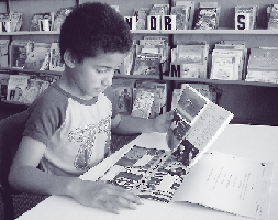New
Zealand’s National Education Monitoring Project commenced
in 1993, with the task of assessing and reporting on the achievement
of New Zealand primary school children in all areas of the school
curriculum. Children are assessed at two class levels: year 4 (halfway
through primary education) and year 8 (at the end of primary education).
Different curriculum areas and skills are assessed each year, over
a four year cycle. The main goal of national monitoring is to provide
detailed information about what children can do so that patterns
of performance can be recognised, successes celebrated, and desirable
changes to educational practices and resources identified and implemented.
Each year, small random samples of children are selected nationally,
then assessed in their own schools by teachers specially seconded
and trained for this work. Task instructions are given orally by
teachers, through video presentations, on laptop computers, or in
writing. Many of the assessment tasks involve the children in the
use of equipment and supplies. Their responses are presented orally,
by demonstration, in writing, in computer files, or through submission
of other physical products. Many of the responses are recorded on
video-tape for subsequent analysis.
The use of many tasks with both year 4 and year 8 students allows
comparisons of the performance of year 4 and 8 students in 2001.
Because some tasks have been used twice, in 1997 and again in 2001,
trends in performance across the four year period can also be analysed.
In 2001, the third year of the second cycle of national monitoring,
three areas were assessed: mathematics, social studies and information
skills. This report presents details and results of the assessments
of information skills.
Assessing information skills
Chapter 2 explains the
place of information skills in the New Zealand curriculum and presents
the framework for information skills. This identified three main
content areas or strands: clarifying information needs, finding
and gathering information, and analysing and using information.
Within each of these areas, various strategies, skills and processes
were identified. The importance of attitudes and motivation was
also noted.
Clarifying information needs
Chapter 3 presents information
about students’ skills in clarifying information needs based
on six assessment tasks. Year 8 students enjoyed substantially more
success than year 4 students. Averaged across 15 task components
attempted by both years, 23 percent more year 8 than year 4 students
succeeded well with these components. On most components, 60 to
80 percent of year 8 students performed quite strongly, compared
to 35 to 55 percent of year 4 students.
There was little evidence of change between 1997 and 2001. Averaged
across 9 task components attempted by year 4 students in both years,
1 percent fewer students succeeded in 2001 than in 1997. At
year 8 level, again with 9 components included, 3 percent fewer
students succeeded in 2001 than in 1997. These differences are too
small to be regarded as important.
Finding
and gathering information
Chapter
4 presents results for eighteen tasks that involved finding
and gathering information. Year 8 students enjoyed substantially
more success than year 4 students. Averaged across 23 task components
attempted by both years, 21 percent more year 8 than year 4 students
succeeded well with the components. Most students were quite successful
at locating specified information in printed resources, understanding
how these resources are structured, and understanding which are
most suitable for particular purposes. Fewer had clear understanding
of how libraries are organised, were good at notetaking, or explained
fully the range of pro-cesses involved in project work. Few year
4 students were successful with the two tasks that simulated web
searching.
There was evidence of modest improvement between 1997 and 2001 for
year 4 students, but little change for year 8 students. Averaged
across 29 task components attempted by year 4 students in both years,
5 percent more students succeeded with these components in 2001
than in 1997. At year 8 level, with 48 components included in the
analysis, 1 percent fewer students succeeded in 2001 than in
1997.
Analysing
and using information
Chapter 5 presents
results for eleven tasks that asked students to analyse and use
information. Year 8 students enjoyed substantially more success
than year 4 students on two of the three task attempted by both
years, with little difference on the third. Averaged across the
17 task components of the three tasks, 12 percent more year 8 than
year 4 students succeeded well with these components. Where the
analysis required involved higher levels of inference, both year
4 and year 8 students performed much less well than where less judgement
was required.
Information Skills Survey
Chapter 6 focuses on the results
of a survey that sought information from students about their strategies
for, involvement in, and enjoyment of information gathering and
interpreting activities. A substantially greater proportion of year
8 than year 4 students reported that they had to find information
for a project or topic heaps or quite a lot. Perhaps as a consequence
of being given such tasks more frequently, year 8 students were
much less inclined than year 4 students to be enthusiastic about
hunting for information and about writing down the information they
found. While year 4 students responded similarly to questions 1
and 2, the pattern was quite different for year 8 students, suggesting
that many of the information finding projects which year 8 students
were asked to attempt were not viewed as “really interesting”.
Most students are quite happy to share with others the information
they have found. Where comparisons with 1997 responses are possible,
the results in 2001 and 1997 are verysimilar, so that the same conclusions
apply.
Performance of subgroups
Chapter 7 details the
results of analyses comparing the performance of different demographic
subgroups. Statistically significant differences of task performance
among the subgroups based on school size, school type, community
size or geographic zone occurred for few tasks. There were no differences
in task performance for year 4 girls and boys, but girls performed
better than boys on 28 percent of the year 8 tasks. Compared to
boys, girls at both levels indicated greater enjoyment of searching
for information and also for writing down what they find out. Non-Mäori
students performed better than Mäori students on 31 percent
of the year 4 tasks, increasing to 56 percent for the year
8 tasks. The SES index based on school deciles showed the strongest
pattern of differences, with differences on 43 percent of tasks
for year 4 students and 71 percent of tasks for year 8 students.
Compared to the previous assessments four years earlier (1997),
there are some noteworthy differences. The 1997 year 4 students
showed differences in task performance between boys and girls on
30 percent of the tasks and between Mäori and non-Mäori
students on 55 percent of the tasks. These differences are maintained
for the same cohort four years later, now at year 8 level, and are
also similar to the year 8 results from 1997. The 2001 year 4 students,
in contrast, show no differences in task performance for boys and
girls, and differences between Mäori and non-Mäori students
on only 31 percent of the tasks. These are substantial reductions
in disparities between boys and girls and between Mäori and
non-Mäori students.
Pacific subgroups
Chapter 8 reports the results
of analyses of the achievement of Pacific students. Additional sampling
of schools with high proportions of Pacific students permitted comparison
of the achievement of Pacific, Mäori and other children attending
schools that have more than 15 percent Pacific students enrolled.
The results apply only to such schools.
In schools with more than 15 percent Pacific students, year 4 Pacific
students performed similarly to their Mäori peers, but a little less
well than “other” students. Year 8 Pacific students performed
a little better than their Mäori peers and close to the levels of
“other” students.
 nit
nit